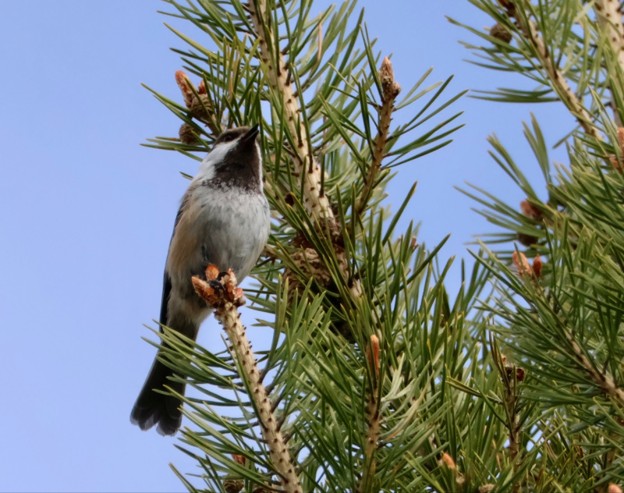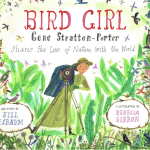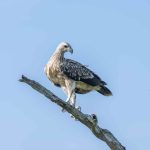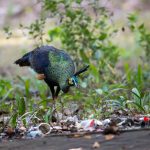
By Catherine Carroll
Cathy Carroll is a native Michigander, the Great Lakes state in the U.S., but became a birder in the Baltimore, Maryland, and Maryland’s Eastern Shore areas (the mid-Atlantic region) in the late 90’s. She was enticed by a birding friend to travel back to Michigan to see the Kirtland’s Warbler for her friend’s life list. She found the whole experience completely riveting and was hooked. Since that first experience, Cathy has seen Kirtland’s Warbler many times, each encounter as delightful as the first. In 2006, Cathy took the opportunity to take her first birding trip abroad – to Cuba – and she has traveled widely since then. On her recent trip to Finland and Norway, she learned that she was the least well-traveled, by far, birder on the trip. That was a humbling awareness. Her style of birding now is to select a few special birds each year and try to see them. This fuels her ongoing interest in birds and the unrelenting issues that threaten them. This year, she missed seeing the Golden-winged Warbler by 18 hours.
On my recent trip to Finland at the end of May, our field guide called in a Siberian Tit (Poecile cinctus) with playback. The bird flew in almost immediately. It perched up in the open and remained for us to take our fill of photos. I think it also made some little vocalizations. Thrilled that it had perched in the open and made our photos so easy, we left the little bird before it flew off. Check!
Most but not all participants on this trip were Americans. On the walk back to the vans, our other guide (we had two) ignited a tiny bit of friendly banter when he said, with mild derision, that in North America this bird is called the Gray-headed Chickadee. But, he was adamant, the proper name for this bird is Siberian Tit, further explaining that it occupies only a tiny range in Alaska, but breeds all across a large swath of Siberia. We were actually near the border with Russia when we saw the Siberian Tit. No one disputed him. I love chickadees generally, and I loved seeing this Siberian Tit. Naturally, it is a target bird for this trip.
After returning home, I wrote about the Siberian Tit and its supporting anecdote, and thought that would be all. I didn’t give another thought to it until two days ago, when I picked up my July issue of the ABA Birding magazine (Vol. 57, No. 4), which had arrived in my mailbox a day earlier. The central article was titled Lost in the Frontier by Brad Meiklejohn, pages 30-45, and reported the grim news that the Gray-headed Chickadee, despite intense searching, had not been seen in Alaska or in northwest Canada since 2018. The author further hypothesized that the Gray-headed Chickadee is extirpated from North America. He offered a variety of possible reasons for its disappearance, but mostly it is not known why the Gray-headed Chickadee has disappeared. The article is also accompanied by beautiful photos. Lost on the Frontier is not a high-science study; rather, it is a well-written and informative piece written by a leader with the Conservation Fund and has been published by a popular, non-academic birding publication. Perhaps it’s my imagination, but I thought I could feel the author’s sadness in his writing.
I sent the article’s link to our Finland and Norway field guide. I felt sure he would want to read the article, but learned that the link would not open for non-ABA members.
The Eskimo Curlew’s (Numenius borealis) last confirmed sighting was in Galveston, Texas in 1962. There were two. Victor Emanuel, only recently deceased, was one of the persons to see the last two birds. He wrote about this as being the most memorable event in his birding life.
There is some dispute about when the last confirmed Bachman’s Warbler (Vermivora bachmanii) was seen, but there seems to be general agreement about a sighting near Charleston, South Carolina, also in 1962. A singing male was seen near I’on Swamp. In the case of both birds, there were reports of more recent sightings; yet all of these were unconfirmed. This information, and more, is easily accessible by doing a simple Google search.
The author writes about the Thick-billed Parrot and Aplomado Falcon (page 44) as analogous to the Gray-headed Chickadee. Both disappeared from the American Southwest in the early 20th century. (I have to remind myself that we are now in the 21st century). But both birds exist in good numbers in adjacent Mexico and could conceivably repopulate their former habitats. That’s a hard one. The habitat has changed dramatically. It is highly unlikely, even impossible, that a Siberian Tit would fly across the Bering Straits to land in Alaska and begin to repopulate.
I live in the northern midwest part of the United States, thousands of miles from Alaska’s Brooks Range, one of the Gray-headed Chickadee’s stronghold habitats. Practically speaking, I was never going to travel to this part of Alaska, even less likely to NW Canada, to see the Gray-headed Chickadee. Many, many birders did, however. Also, these vast areas of Alaska have many old-timer-like trappers and hunters who have cabins in these habitats. They once reported that Gray-headed Chickadees were the most numerous birds at their feeders. The chickadees became fewer and fewer, and they now report the birds’ absence. It’s an absence that I feel certain they must miss. This article has also made me feel deeply saddened. And, it makes the Siberian Tit we saw near Kuusamo in Finland all the more special. While the Siberian Tit is considered a bird of least concern in its Siberian range, I pointed out to our field guide that it was, nonetheless, the only Siberian Tit we saw.
Photo: Siberian Tit (Poecile cinctus), near Kuusamo, Northern Ostrobothnia
References
- Lost on the Frontier: The Mysterious Disappearance of North America’s Rarest Breeding Bird by Brad Meiklejohn. ABA Birding Magazine, Vol. 57, No. 4, July 2025, pages 30-45.
- The Eskimo Curlew Hasn’t Been Seen in 55 Years. Is It Time to Declare It Extinct?, by Amy Lewis, Audubon Magazine, audubon.org. April 20, 2018.
Notes
- I am a subscriber to the ABA and receive their monthly magazine in the mail. It is also online, but non-members are unable to open the link to the article. You may find it on your local bookstore’s newsstand, or you may also be able to obtain it from your local library.
- I am not a subscriber to the Audubon organization. I was, however, still able to open the above article online. The article opens with Victor Emanuel’s memory of seeing the Eskimo Curlew. It reads beautifully and is very poignant for us to read, especially since his death..













Hi Cathy – I’ve seen Aplomado Falcons more than once in the Lower Rio Grande Valley. Efforts to get them to breed there have been working. You can read about my last sighting in my August 7, 2024 blog post.
Leslie, thanks for pointing this out. The author of the Birding article does briefly discuss that both birds were reintroduced. He writes: ” An attempted reintroduction of the parrots into the Chiricahua Mountains of Southeast Arizona failed in the 1980s and 1990s; a reintroduction of the falcons in South Texas is ongoing with some success. There have been isolated records of both species in recent decades in the Southwest.” I should have made this clearer in my writing. I was trying to imply that the geography would allow the parrot and the falcon to return on their own, but that the ease of geography does not exist for the Gray-headed Chickadee. He discussed briefly the perils of reintroduction of the chickadee, especially because it is not known why it has disappeared. Thanks for pointing this out. I hope you can find the article. I will definitely look up your blog post.
It’s clear why the chickadees left Alaska, it’s on Discovery Channel every day: all these people “surviving Alaska” by bringing all sorts of equipment except razors 😉 I would leave too.
This is funny Peter. Yes, there are elements of truth to it and a few razors are indeed needed.
Yep. I know that feeling: https://www.10000birds.com/this-is-my-dream-this-is-my-nightmare.htm
Here is a link to the article:
https://theconservationfund-my.sharepoint.com/:b:/g/personal/bmeiklejohn_conservationfund_org/EaIm4cTOjPVMlLAksMNr_v0B6f_t9nlZnnVdEkpfRbiXeQ
Here is a better link to the article:
https://www.aba.org/lost-on-the-frontier/